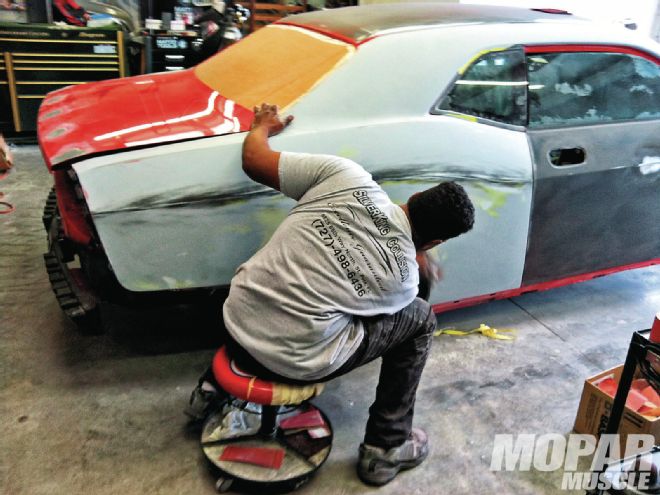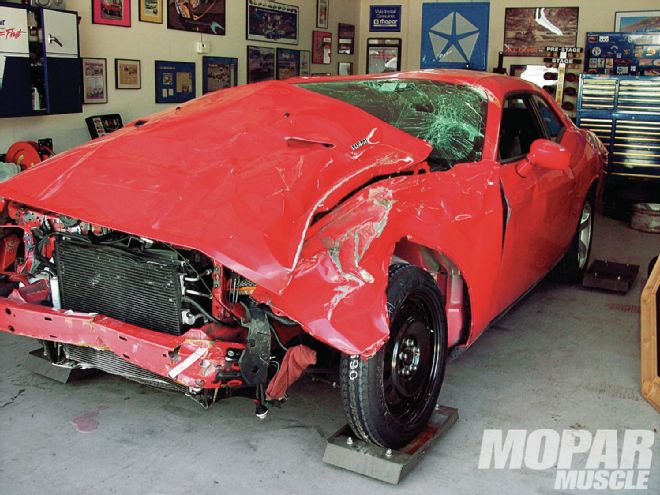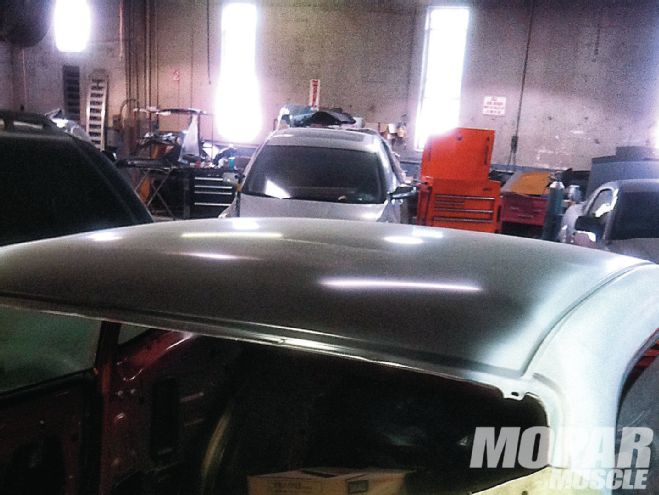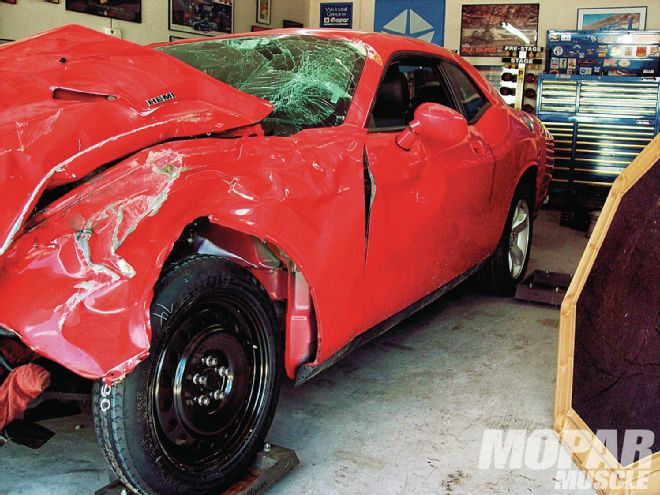
When it comes to late-model Mopars and drag racing, we know what you’re thinking: These cars are too expensive to make into dedicated drag racing vehicles. And while purchasing a new Challenger off the dealership lot, or acquiring one of the limited edition Dodge Drag Pak vehicles may not be in your budget, there is another way to build a late-model race car. Just like muscle cars of the ’60s and ’70s, many new Dodge Challenger and Charger R/T and SRT models are being sold to anyone who can get financing or write a check, and not necessarily strictly to drivers that can handle the cars. As a result, we’re seeing these cars show up at auctions and scrap yards after being wrecked, and many of these vehicles can be had for pennies on the dollar, depending on the extent of damage they’ve incurred.
Of course, there are drawbacks to purchasing a wrecked car and using it to build a race car, but there are many distinct advantages as well. On the drawback side, it’s a lot of work to rebuild a car that has been in a bad collision, and you’d better enjoy bodywork or have a friend who owns a body shop to fix one of these cars properly. If the car has had substantial damage, the frame may be tweaked as well, requiring the car to be re-squared before it can be safely driven or raced. Additionally, cars that have received extensive damage in an accident, often come with what’s called a salvage title, meaning they are either only good for parts, or they must be rebuilt and inspected by the DOT before they can be put back on the road. For the purposes of racing however, this last drawback isn’t much of a concern, and can lead to a good deal.
 01] This ’10 Challenger was rolled over in an accident with only 18,000 miles on the odometer. Though considered totaled and not a good candidate to rebuild as a street car, this is a great starting point for a dedicated late-model race car. This Challenger suffered substantial damage, so after removing all of the crunched body parts, we had the body shop put the car on the frame machine to make sure it was straight and square prior to replacing parts like the inner fenders and sending the car to the chassis shop to install the aftermarket rear suspension.
01] This ’10 Challenger was rolled over in an accident with only 18,000 miles on the odometer. Though considered totaled and not a good candidate to rebuild as a street car, this is a great starting point for a dedicated late-model race car. This Challenger suffered substantial damage, so after removing all of the crunched body parts, we had the body shop put the car on the frame machine to make sure it was straight and square prior to replacing parts like the inner fenders and sending the car to the chassis shop to install the aftermarket rear suspension.
On the positive side, purchasing a wrecked late-model Mopar generally means that you can score the car for a lot less than the sticker price. Cars that are considered totaled, generally sell at auction for a quarter or less of the new value, depending on the damage, and more damage can lead to a better deal. As an added benefit, these cars often have low mileage, and many parts such as the interior and drive train can be salvaged and sold to recover the money invested in the car. Of course, you’ll have to have a dealer’s license to buy a car at an auction, and many salvage yards won’t sell you a wrecked car in entirety since its worth more to them as parts, but if you know a dealer or have some connections, these cars can be had.
Since our friend Fred Menditto is a local Florida dealer specializing in wholesale vehicles, he has just the credentials necessary to pick up one of these damaged cars at auction. Fred and his family are also dedicated Mopar racers, and both of the Menditto kids grew up at the track driving “Mopar” junior dragsters and funny cars, and eventually racing a series of big-block and Hemi powered Dusters at tracks in Florida, and the Southeast. At the car auctions that Fred attends for his business, he began noticing damaged late-model Mopars showing up, so he decided his son Rick’s next drag car would be a new Dodge Challenger.
 02] One of the major items that needed to be replaced was the roof skin. Fortunately, new sheetmetal is available from Chrysler, and costs less than $300. Body shops like Silverking Collision Center specialize in late-model vehicles, so they were happy to work on our Challenger.
02] One of the major items that needed to be replaced was the roof skin. Fortunately, new sheetmetal is available from Chrysler, and costs less than $300. Body shops like Silverking Collision Center specialize in late-model vehicles, so they were happy to work on our Challenger.
Eventually Fred found a deal on a ’10 Challenger R/T that was involved in a rollover accident, and purchased the car as a foundation. We decided to follow along as Fred transformed this car into a cool, late-model drag car, and teamed up with Fred and his son Rick to build this car in to a competitive racer. In previous issues of Mopar Muscle, we’ve tackled the car’s front and rear suspension, brakes, fuel system, and transmission. We also showed how great the third-generation Hemi engine is by teaming up with Indy Cylinder Head to build a powerful 426-inch powerplant, making 719 horsepower on 93 octane pump gas with a relatively mild hydraulic roller cam and single 950-cfm carburetor. This month we’ll show you how this totaled Challenger was made to look new again, with the help of Silverking Collision Center in St. Petersburg, Florida.
Prior to building this Challenger into a race car, Fred completely disassembled the car and sold the engine, transmission, rear differential, and much of the interior to recoup nearly all of the money he spent on the car. This car only showed some 18,000 miles on the odometer, so most of the items that weren’t damaged in the accident brought premium money on the used parts market. With a little more than the cost of investment recovered, it was time to find the body parts necessary to get this Challenger looking new again. Luckily, since these cars are still in production, body parts are available from both the dealer and aftermarket manufacturers, and are relatively inexpensive when compared to body parts for early Mopars. This is a nice benefit since this Challenger needed nearly every body panel to be replaced or repaired, due to the damage in the accident.
Prior to taking the Challenger to Silverking Collision Center, Fred began acquiring the needed body panels himself by checking prices for both new and used items. Having worked previously as a parts manager at a couple of different Chrysler dealerships, Fred took advantage of his experience and obtained many of the parts like the roof skin, door skins, inner fenders, and rear bumper cover straight from Chrysler. Other parts, like the fenders, mirrors, and front bumper covers he purchased used to save a few bucks. Once all of the parts were obtained, the Challenger was sent to the body shop so the work could begin.
Repairing body damage to a late-model Mopar is often far easier than getting your classic car repaired. Most body shops specialize in cars that are currently being produced, since they are the cars that are most often damaged in accidents. While many body shops say they’ll repair or paint your classic Mopar, we’ve had some bad experiences watching our vehicles sit at the body shop, sometimes for years, while the shop knocks out the late-model work quickly. Fortunately, Silverking’s owner Steve Smyrski is very adept at repairing new Dodge vehicles, and wasn’t scared to tackle this Challenger even though the damage was substantial.
This car actually required two visits to the body shop, as the frame first needed to be checked before the car was sent to the chassis shop for the back-half aftermarket chassis to be installed. After the chassis work was complete, the car was taken back to Silverking so the new body panels could be installed, the bodywork could be completed, and the car could be painted. In some areas, like the rear quarter panels, the damage to this vehicle wasn’t bad enough to require panel replacement. Other areas, like the fenders, roof skin, and door skins, were damaged enough that it just didn’t make sense to repair the panels and it was quicker and more economical to simply replace them.
With the new panels welded and bolted in place, the team at Silverking got busy performing the final bodywork, and block sanding the panels. Having some prior body shop experience, Fred performed much of the time consuming block sanding himself, saving the cost of paying the body shop for this additional labor. When the Challenger’s panels were deemed straight and ready for paint, the Challenger was rolled into the paint booth so that painter Matt Raghoo could apply the base and clear coats of BASF’s Glasurit 90 line of waterborne paint. Since this Challenger was already painted in the high impact color of Tor-Red, Fred chose to stay with the factory color, which is coded PR3.
We must admit we were impressed at the outcome of this project. Thanks to the hard work performed by Fred and the crew at Silverking Collision Center this Challenger truly looks like it was never wrecked. Looking at the photos of the car when it was purchased at the auction, it’s difficult to believe that the final result could look so good. This is definitely turning out to be a nice racecar, and certainly worthy of our 700-plus horsepower third-generation Hemi engine. Be sure to follow along as we finish the car in upcoming issues, and get our Challenger to the track for some real world testing.
Price tag Part Part Number Cost Roof Skin PN 5112795ab $242.00 Right Door Skin PN 4816156ad $229.00 Left Door Skin PN 4816157ad $229.00 Right Inner Fender PN 5065504ae $50.50 Left Inner Fender PN 5065505ae $50.75 Headlamp Support Panel PN 5028743ac $244.00 Rear Bumper Cover PN 68038500ac $585.00 Rear Filler Panel PN 68039502aa $89.20 Rear Lower Cover PN 68039501ab $68.45 Rear Cover Absorber PN 68020697ab $148.00 Razor’s Edge Aluminum Front Support $229.95 Used Right Fender $155.00 Used Left Fender $172.00 Used Headlamps $200.00 Used Hood $150.00 Used Front Cover, Grille, Bezels $600.00 Used Mirrors, Pair $250.00 Aftermarket Windshield $225
 10b]
10b]